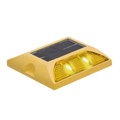
This paper was presented at the 8th IRF World Meeting, Tokyo, Japan, October 16-21, 1977.A plastic reflector is placed over the metal frame and increases. Find a library where document is available. Apex and 3M Reflective and Non-Reflective Pavement Markers, Prismatic, Ceramic, Butyl Pads Retroreflective Plastic Pavement Markers Non-reflective Ceramic. The pavement markers are H-shaped pieces of cast iron embedded in the roadway with an adhesive.They are also relatively economical, due to their use of installation and desirability. By resulting in the safe increase of trafic volume and density, the use of these markers can improve traffic control. Typical examples of their use include two land centerlines, lane lines on multilane highways, traffic islands, pavement arrows, exit ramp delineation, construction zones, and where lanes narrow or are reduced in number as well as high hazard locations, such as sharp or reverse curves, hills, or dangerous intersections. Their main advantage over previous pavement marking and delination systems is the provide guidance at night and during inclement weather. Road markings that deliver continuous wet retroreflectivity can be reliably seen in wet conditions.
#Highway road reflectors drivers
The new stripes may look like paint, but they are tape or thermal plastic embedded with glass beads.BENEFITS OF USING RAISED REFLECTIVE PAVEMENT MARKERS IN ROADWAY DELINEATIONĪn important advancement in traffic engineering for the improvement of safety, mobility and guidance in recent years has been the introduction of raised reflective pavement markets which are raised above the surface moisture, sloped to permit easy safe crossing by automobile tires, and employ the cube corner technique of light reflectance from vehicle, headlights. Wet reflectivity It’s critical that machine vision systems and human drivers can detect road markings in all conditions including when it’s raining and the roads are wet. The stripe on the left in the photo above is the newly required 6-inch-wide stripe.The stripe on the right has Botts dots, is 4 inches wide and will someday be replaced.Eventually, the entire state highway system will have 6-inch-wide striping. At 65 mph, you would pass two markers 48 feet apart in less than a second. Raised pavement markers are approximately 48 feet apart on a highway but vary in distance depending on the type of road or lane. New, more reflective markers are replacing the old Botts dots. for public highway use (this does not mean they cannot be used on private roads and car parks). You can find a stretch along the 5 freeway that shows the past and future of California’s roads. Temporary Reflective Road Studs Temporary & Permanent. M12: 2022 specification replaces the version issued in 2007.

But how well do you know those roads you traverse? Here’s a look at some of the more visible changes along California’s estimated 394,608 miles of lanes. Markers that have current approval in terms of M12 for use on state highways are listed in M12-L. Help guests identify driveway entrances and what path to follow.

Driveway reflectors come as rods with a round plastic reflector at the end. Creepy night highway through forest in foggy moonlight Stock Photo. Using reflectors is a simple and necessary precaution for traffic safety. Find Road Reflector stock images in HD and millions of other royalty-free stock.

Californians spend a lot of time on the road, especially in the summer when we set out on vacation or head to the beach. A reflector helps highlight people or routes that are obscured in the dark or bad weather.


 0 kommentar(er)
0 kommentar(er)
